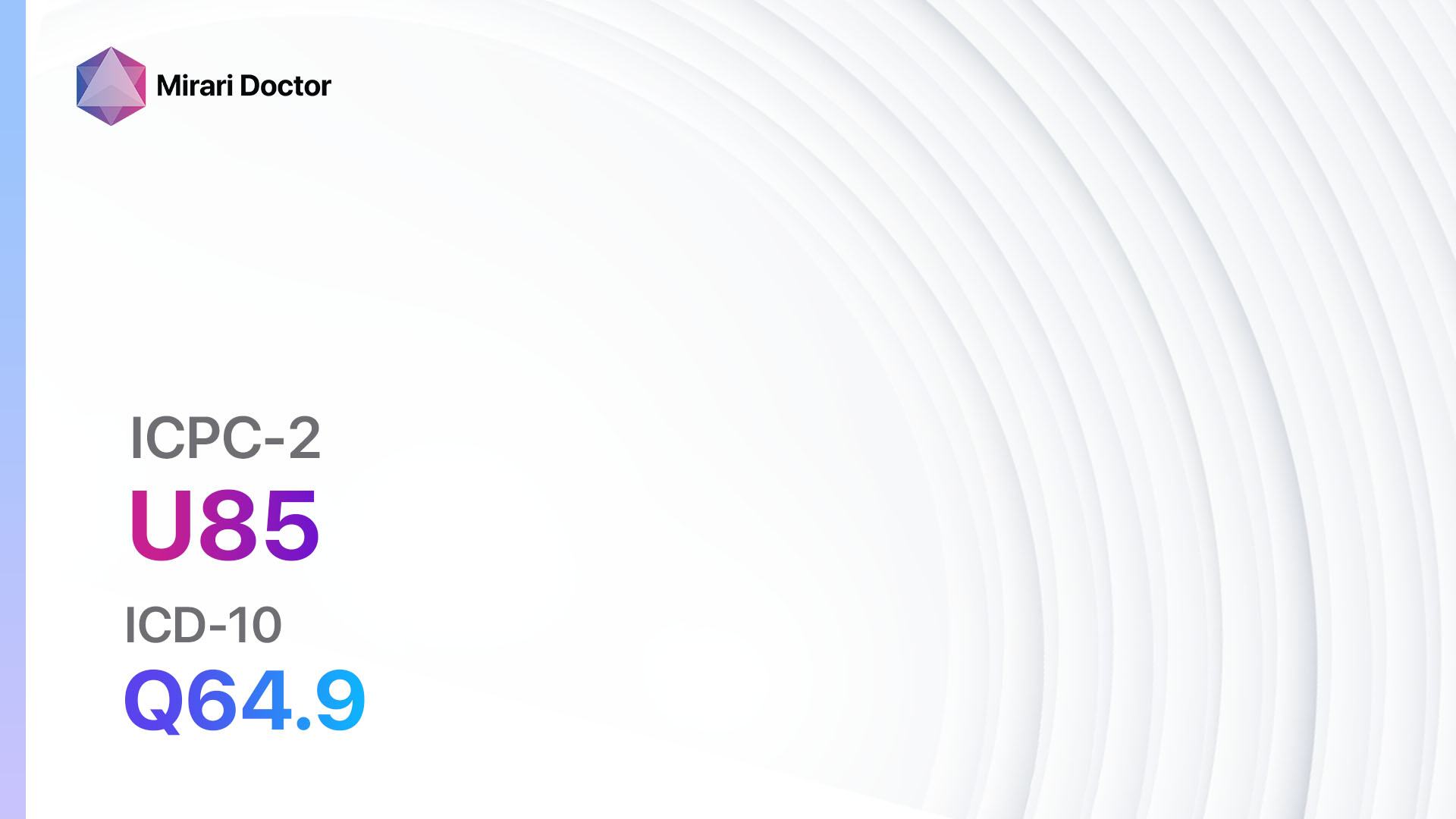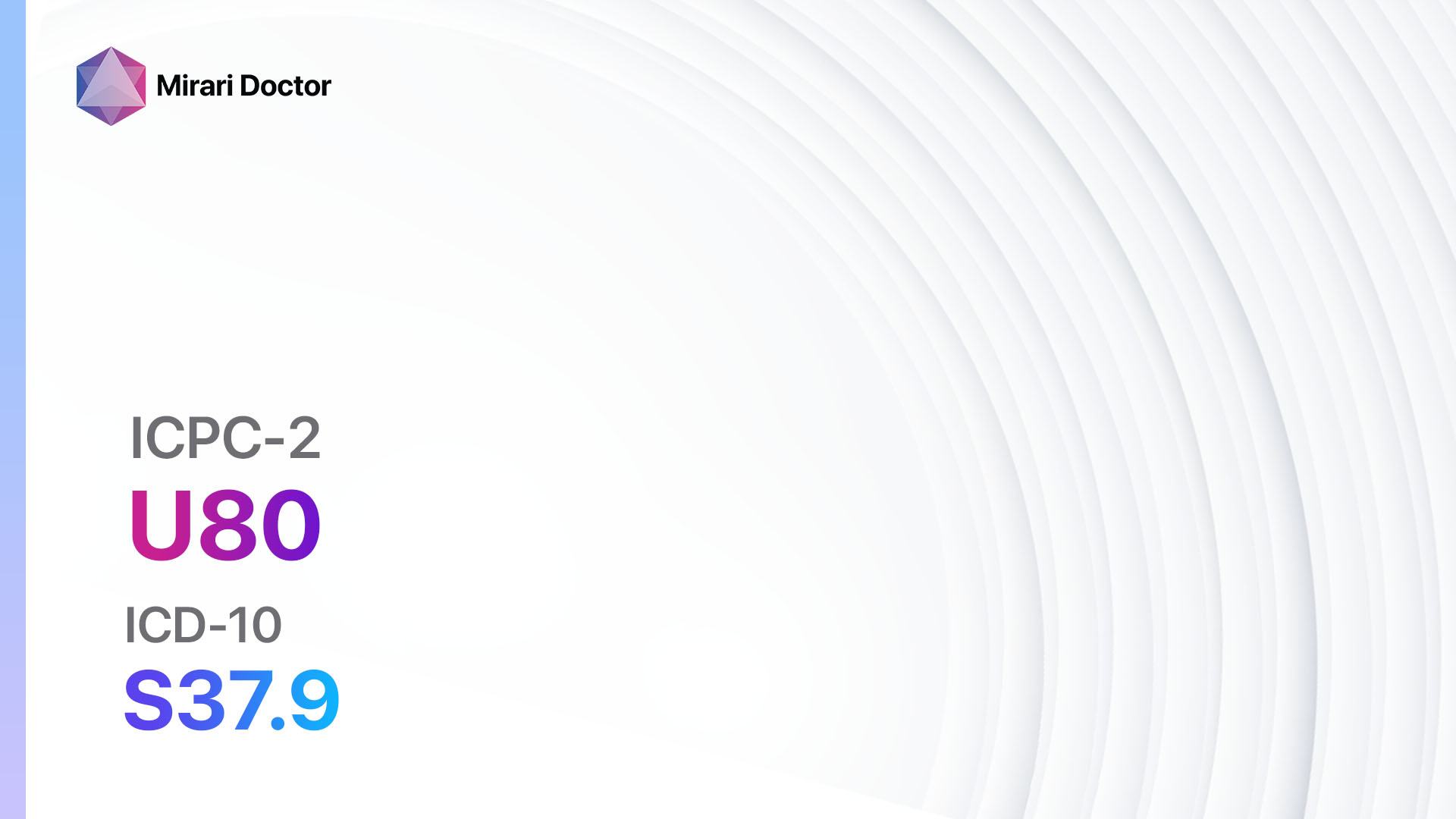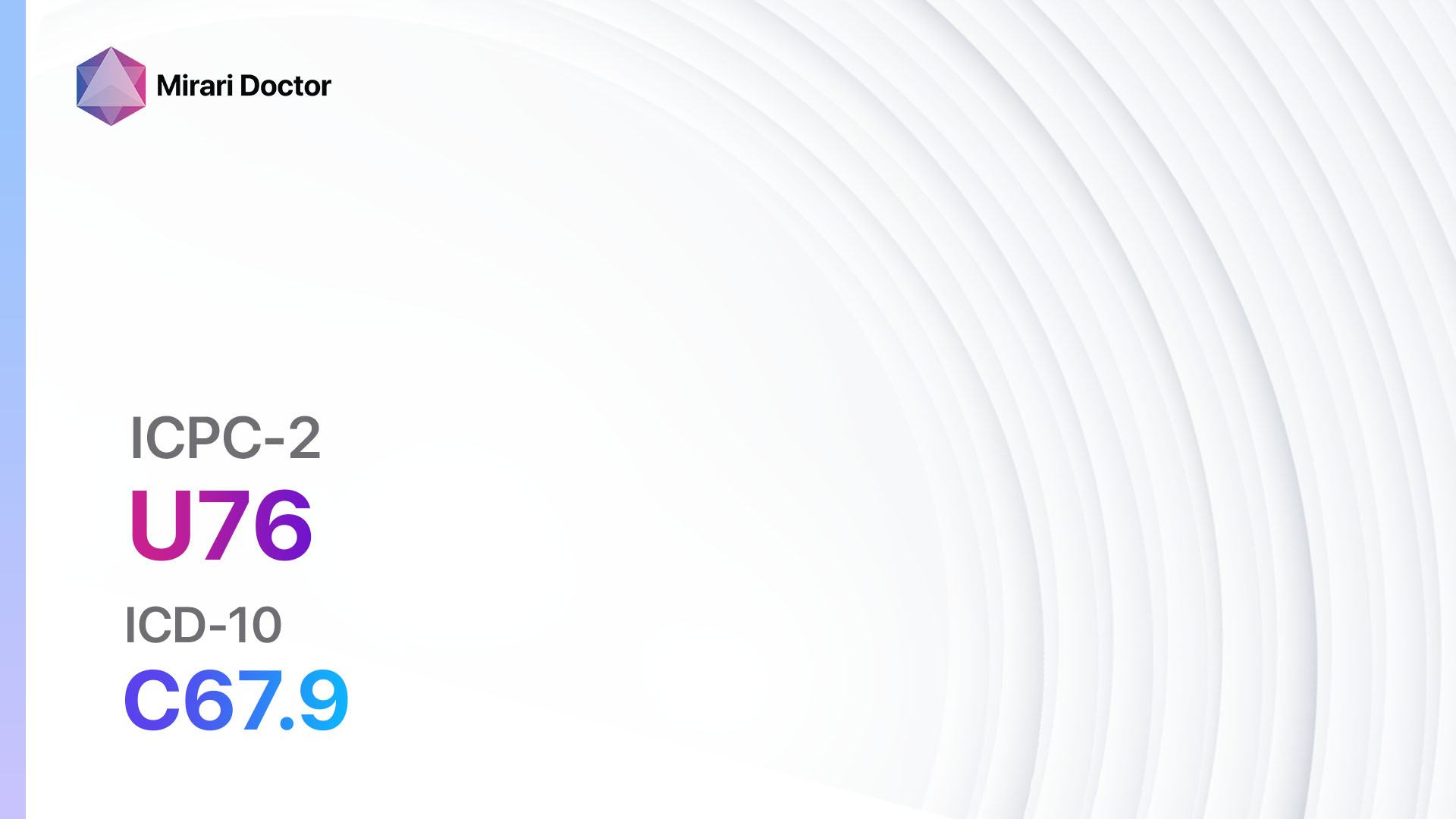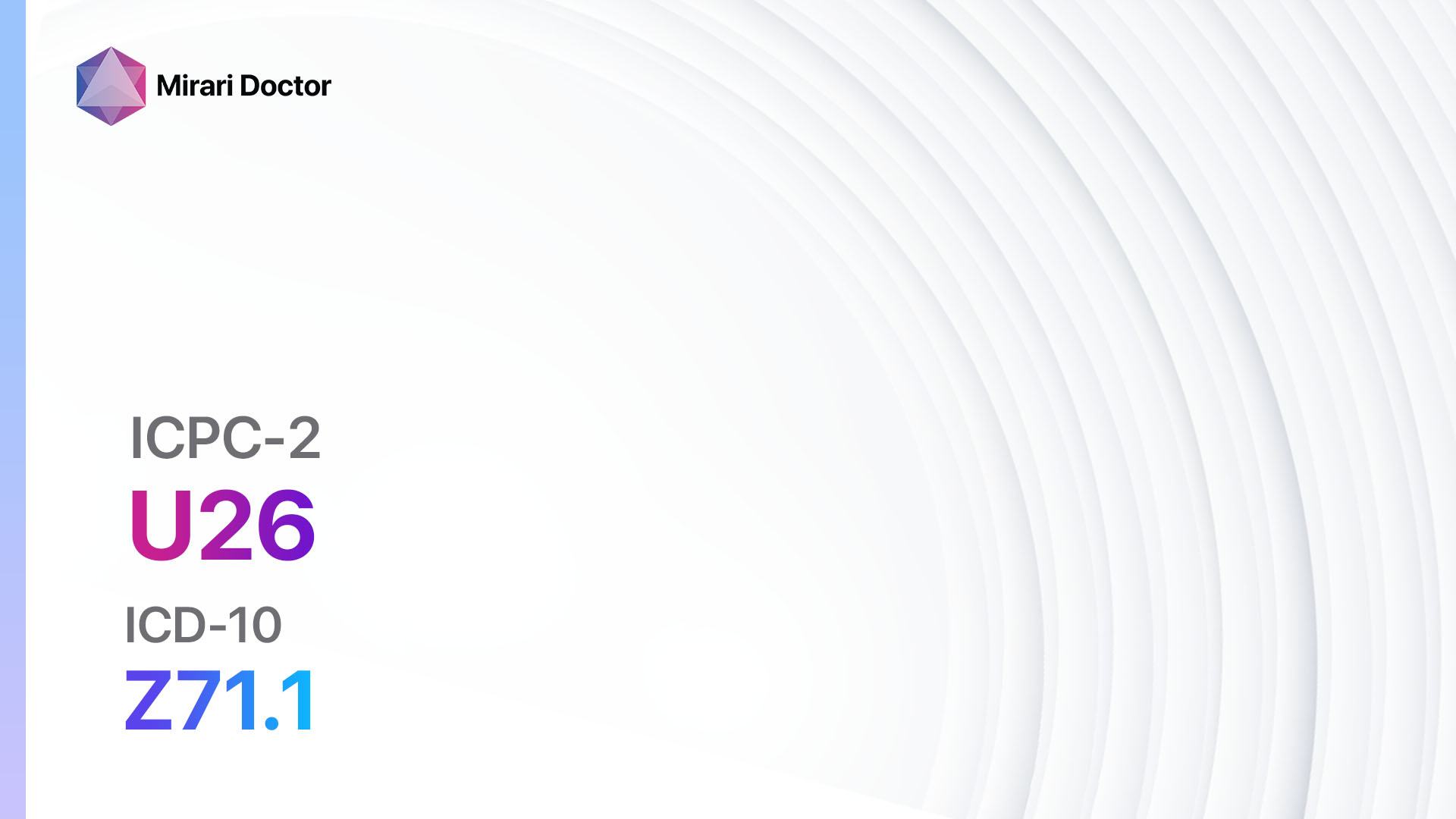
Introduction
Bladder symptoms or complaints refer to any issues or abnormalities related to the bladder. These can include urinary frequency, urgency, incontinence, pain, or difficulty urinating. It is important to address these symptoms promptly as they can significantly impact a person’s quality of life[1]. This guide aims to provide an overview of the symptoms, causes, diagnostic steps, possible interventions, and patient education related to bladder symptom/complaint other.
Codes
- ICPC-2 Code: U13 Bladder symptom/complaint other
- ICD-10 Code: R39.8 Other specified symptoms and signs involving the urinary system[2]
Symptoms
- Urinary frequency: Increased need to urinate more often than usual.
- Urinary urgency: Sudden and intense urge to urinate.
- Urinary incontinence: Involuntary leakage of urine.
- Painful urination: Discomfort or pain during urination.
- Difficulty urinating: Struggling to start or maintain urination[3].
Causes
- Urinary tract infection (UTI): Bacterial infection in the urinary tract.
- Bladder stones: Hard deposits that form in the bladder.
- Bladder cancer: Abnormal growth of cells in the bladder.
- Bladder outlet obstruction: Blockage in the urinary tract that prevents normal urine flow.
- Neurological disorders: Conditions that affect the nerves controlling the bladder[4].
Diagnostic Steps
Medical History
- Gather information about the patient’s symptoms, including frequency, duration, and severity.
- Ask about any previous urinary tract infections or bladder-related issues.
- Inquire about any underlying medical conditions or medications that may contribute to bladder symptoms.
- Assess the impact of symptoms on the patient’s daily life and quality of life[5].
Physical Examination
- Perform a general physical examination to assess overall health.
- Conduct a focused examination of the abdomen and pelvic region.
- Palpate the bladder to check for any abnormalities or tenderness.
- Evaluate the nervous system for any signs of neurological disorders[6].
Laboratory Tests
- Urinalysis: Analyze a urine sample for signs of infection, blood, or other abnormalities.
- Urine culture: Identify the specific bacteria causing a urinary tract infection.
- Blood tests: Check for any abnormalities in kidney function or markers of inflammation.
- Bladder diary: Have the patient record their fluid intake, urinary frequency, and any episodes of incontinence over a specific period[7].
Diagnostic Imaging
- Ultrasound: Use sound waves to create images of the bladder and surrounding structures.
- Cystoscopy: Insert a thin tube with a camera into the urethra to visualize the bladder.
- CT scan: Provide detailed cross-sectional images of the urinary tract.
- MRI: Use magnetic fields and radio waves to generate images of the bladder and nearby organs[8].
Other Tests
- Urodynamic testing: Measure bladder pressure and urine flow during urination.
- Cystogram: Inject contrast dye into the bladder and take X-rays to evaluate bladder function.
- Biopsy: Collect a sample of bladder tissue for further analysis in suspected cases of bladder cancer.
- Neurological evaluation: Assess nerve function and control of the bladder in cases of suspected neurological disorders[9].
Follow-up and Patient Education
- Schedule follow-up appointments to monitor the effectiveness of interventions and adjust treatment if necessary.
- Provide education on bladder health, including maintaining good hydration, practicing pelvic floor exercises, and avoiding bladder irritants such as caffeine and alcohol.
- Discuss strategies for managing bladder symptoms, such as timed voiding, bladder training, and lifestyle modifications.
- Address any concerns or questions the patient may have regarding their condition or treatment[10].
Possible Interventions
Traditional Interventions
Medications:
Top 5 drugs for bladder symptom/complaint other:
- Anticholinergic medications (e.g., Oxybutynin, Tolterodine):
- Cost: Generic versions can be $10-$50/month.
- Contraindications: Glaucoma, urinary retention, gastrointestinal obstruction.
- Side effects: Dry mouth, constipation, blurred vision.
- Severe side effects: Confusion, hallucinations, difficulty urinating.
- Drug interactions: Other anticholinergic drugs, certain antidepressants.
- Warning: Use with caution in elderly patients due to increased risk of cognitive impairment.
- Alpha-blockers (e.g., Tamsulosin, Alfuzosin):
- Cost: Generic versions can be $10-$50/month.
- Contraindications: Hypotension, severe liver disease.
- Side effects: Dizziness, headache, nasal congestion.
- Severe side effects: Fainting, priapism (prolonged erection).
- Drug interactions: Other alpha-blockers, certain antihypertensive medications.
- Warning: Take medication at bedtime to minimize dizziness.
- Mirabegron:
- Cost: $100-$200/month.
- Contraindications: Severe uncontrolled hypertension, severe liver impairment.
- Side effects: Increased blood pressure, headache, urinary tract infection.
- Severe side effects: Angioedema, severe allergic reactions.
- Drug interactions: CYP2D6 inhibitors, beta-blockers.
- Warning: Monitor blood pressure regularly during treatment.
- Tricyclic antidepressants (e.g., Amitriptyline, Imipramine):
- Cost: Generic versions can be $10-$50/month.
- Contraindications: Recent myocardial infarction, glaucoma, urinary retention.
- Side effects: Dry mouth, constipation, drowsiness.
- Severe side effects: Cardiac arrhythmias, seizures.
- Drug interactions: MAO inhibitors, other antidepressants.
- Warning: May take several weeks to see the full effect.
- Desmopressin:
- Cost: $50-$100/month.
- Contraindications: Hyponatremia, severe renal impairment.
- Side effects: Headache, nausea, abdominal pain.
- Severe side effects: Water intoxication, seizures.
- Drug interactions: NSAIDs, tricyclic antidepressants.
- Warning: Monitor serum sodium levels during treatment.
Alternative Drugs:
- Botulinum toxin injections: Used in cases of overactive bladder that does not respond to other treatments. Cost: $1,000-$2,000 per treatment.
- Estrogen therapy: For postmenopausal women with bladder symptoms related to hormonal changes. Cost: $20-$50/month.
- Pain medications: Prescribed for patients with bladder pain syndrome or interstitial cystitis. Cost: Varies depending on the specific medication.
Surgical Procedures:
- Bladder augmentation: Enlarges the bladder using a segment of the patient’s intestine. Cost: $20,000-$40,000.
- Urinary diversion: Redirects urine flow to a stoma or pouch outside the body. Cost: $30,000-$50,000.
- Sacral neuromodulation: Implants a device that stimulates the nerves controlling the bladder. Cost: $20,000-$30,000.
Alternative Interventions
- Acupuncture: May help alleviate bladder symptoms by promoting relaxation and improving blood flow. Cost: $60-$120 per session.
- Herbal supplements: Certain herbs, such as saw palmetto and pumpkin seed extract, may have potential benefits for bladder health. Cost: Varies depending on the specific supplement.
- Pelvic floor physical therapy: Involves exercises and techniques to strengthen the pelvic floor muscles and improve bladder control. Cost: $100-$200 per session.
- Behavioral therapy: Teaches techniques to manage bladder symptoms, such as bladder training and urge suppression. Cost: $100-$200 per session.
- Biofeedback: Uses sensors to provide feedback on muscle activity and helps patients learn to control bladder function. Cost: $100-$200 per session.
Lifestyle Interventions
- Fluid management: Encourage patients to maintain a healthy fluid intake and avoid excessive consumption of bladder irritants such as caffeine and alcohol. Cost: Varies depending on individual preferences.
- Bladder training: Teach patients techniques to gradually increase the time between urinations and improve bladder control. Cost: None.
- Weight management: Advise overweight or obese individuals to lose weight, as excess weight can put pressure on the bladder. Cost: Varies depending on individual preferences.
- Pelvic floor exercises: Instruct patients on how to perform exercises to strengthen the pelvic floor muscles and improve bladder control. Cost: None.
- Stress management: Recommend stress-reducing techniques, such as meditation or yoga, as stress can exacerbate bladder symptoms. Cost: Varies depending on individual preferences.
It is important to note that the cost ranges provided are approximate and may vary depending on the location and availability of the interventions.
Mirari Cold Plasma Alternative Intervention
Understanding Mirari Cold Plasma
- Safe and Non-Invasive Treatment: Mirari Cold Plasma is a safe and non-invasive treatment option for various skin conditions. It does not require incisions, minimizing the risk of scarring, bleeding, or tissue damage.
- Efficient Extraction of Foreign Bodies: Mirari Cold Plasma facilitates the removal of foreign bodies from the skin by degrading and dissociating organic matter, allowing easier access and extraction.
- Pain Reduction and Comfort: Mirari Cold Plasma has a local analgesic effect, providing pain relief during the treatment, making it more comfortable for the patient.
- Reduced Risk of Infection: Mirari Cold Plasma has antimicrobial properties, effectively killing bacteria and reducing the risk of infection.
- Accelerated Healing and Minimal Scarring: Mirari Cold Plasma stimulates wound healing and tissue regeneration, reducing healing time and minimizing the formation of scars.
Mirari Cold Plasma Prescription
Video instructions for using Mirari Cold Plasma Device – U13 Bladder symptom/complaint other (ICD-10:R39.8)
| Mild | Moderate | Severe |
| Mode setting: 1 (Infection) Location: 2 (Prostate & Uterus) Morning: 15 minutes, Evening: 15 minutes |
Mode setting: 1 (Infection) Location: 2 (Prostate & Uterus) Morning: 30 minutes, Lunch: 30 minutes, Evening: 30 minutes |
Mode setting: 1 (Infection) Location: 2 (Prostate & Uterus) Morning: 30 minutes, Lunch: 30 minutes, Evening: 30 minutes |
| Mode setting: 6 (Liver/Kidney Therapy) Location: 2 (Prostate & Uterus) Morning: 15 minutes, Evening: 15 minutes |
Mode setting: 6 (Liver/Kidney Therapy) Location: 2 (Prostate & Uterus) Morning: 30 minutes, Lunch: 30 minutes, Evening: 30 minutes |
Mode setting: 6 (Liver/Kidney Therapy) Location: 2 (Prostate & Uterus) Morning: 30 minutes, Lunch: 30 minutes, Evening: 30 minutes |
| Mode setting: 6 (Liver/Kidney Therapy) Location: 3 (Kidney, Liver & Spleen) Morning: 15 minutes, Evening: 15 minutes |
Mode setting: 6 (Liver/Kidney Therapy) Location: 3 (Kidney, Liver & Spleen) Morning: 30 minutes, Lunch: 30 minutes, Evening: 30 minutes |
Mode setting: 6 (Liver/Kidney Therapy) Location: 3 (Kidney, Liver & Spleen) Morning: 30 minutes, Lunch: 30 minutes, Evening: 30 minutes |
| Mode setting: 7 (Immunotherapy) Location: 1 (Sacrum) Morning: 15 minutes, Evening: 15 minutes |
Mode setting:7 (Immunotherapy) Location: 1 (Sacrum) Morning: 30 minutes, Lunch: 30 minutes, Evening: 30 minutes |
Mode setting:7 (Immunotherapy) Location: 1 (Sacrum) Morning: 30 minutes, Lunch: 30 minutes, Evening: 30 minutes |
| Total Morning: 60 minutes approx. $10 USD, Evening: 60 minutes approx. $10 USD |
Total Morning: 120 minutes approx. $20 USD, Lunch: 120 minutes approx. $20 USD, Evening: 120 minutes approx. $20 USD, |
Total Morning: 120 minutes approx. $20 USD, Lunch: 120 minutes approx. $20 USD, Evening: 120 minutes approx. $20 USD, |
| Usual treatment for 7-60 days approx. $140 USD – $1200 USD | Usual treatment for 6-8 weeks approx. $2,520 USD – $3,360 USD |
Usual treatment for 3-6 months approx. $5,400 USD – $10,800 USD
|
 |
|
Use the Mirari Cold Plasma device to treat Bladder symptom/complaint other effectively.
WARNING: MIRARI COLD PLASMA IS DESIGNED FOR THE HUMAN BODY WITHOUT ANY ARTIFICIAL OR THIRD PARTY PRODUCTS. USE OF OTHER PRODUCTS IN COMBINATION WITH MIRARI COLD PLASMA MAY CAUSE UNPREDICTABLE EFFECTS, HARM OR INJURY. PLEASE CONSULT A MEDICAL PROFESSIONAL BEFORE COMBINING ANY OTHER PRODUCTS WITH USE OF MIRARI.
Step 1: Cleanse the Skin
- Start by cleaning the affected area of the skin with a gentle cleanser or mild soap and water. Gently pat the area dry with a clean towel.
Step 2: Prepare the Mirari Cold Plasma device
- Ensure that the Mirari Cold Plasma device is fully charged or has fresh batteries as per the manufacturer’s instructions. Make sure the device is clean and in good working condition.
- Switch on the Mirari device using the power button or by following the specific instructions provided with the device.
- Some Mirari devices may have adjustable settings for intensity or treatment duration. Follow the manufacturer’s instructions to select the appropriate settings based on your needs and the recommended guidelines.
Step 3: Apply the Device
- Place the Mirari device in direct contact with the affected area of the skin. Gently glide or hold the device over the skin surface, ensuring even coverage of the area experiencing.
- Slowly move the Mirari device in a circular motion or follow a specific pattern as indicated in the user manual. This helps ensure thorough treatment coverage.
Step 4: Monitor and Assess:
- Keep track of your progress and evaluate the effectiveness of the Mirari device in managing your Bladder symptom/complaint other. If you have any concerns or notice any adverse reactions, consult with your health care professional.
Note
This guide is for informational purposes only and should not replace the advice of a medical professional. Always consult with your healthcare provider or a qualified medical professional for personal advice, diagnosis, or treatment. Do not solely rely on the information presented here for decisions about your health. Use of this information is at your own risk. The authors of this guide, nor any associated entities or platforms, are not responsible for any potential adverse effects or outcomes based on the content.
Mirari Cold Plasma System Disclaimer
- Purpose: The Mirari Cold Plasma System is a Class 2 medical device designed for use by trained healthcare professionals. It is registered for use in Thailand and Vietnam. It is not intended for use outside of these locations.
- Informational Use: The content and information provided with the device are for educational and informational purposes only. They are not a substitute for professional medical advice or care.
- Variable Outcomes: While the device is approved for specific uses, individual outcomes can differ. We do not assert or guarantee specific medical outcomes.
- Consultation: Prior to utilizing the device or making decisions based on its content, it is essential to consult with a Certified Mirari Tele-Therapist and your medical healthcare provider regarding specific protocols.
- Liability: By using this device, users are acknowledging and accepting all potential risks. Neither the manufacturer nor the distributor will be held accountable for any adverse reactions, injuries, or damages stemming from its use.
- Geographical Availability: This device has received approval for designated purposes by the Thai and Vietnam FDA. As of now, outside of Thailand and Vietnam, the Mirari Cold Plasma System is not available for purchase or use.
References
- Abrams, P., Cardozo, L., Fall, M., Griffiths, D., Rosier, P., Ulmsten, U., … & Wein, A. (2002). The standardisation of terminology of lower urinary tract function: report from the Standardisation Sub‐committee of the International Continence Society. Neurourology and Urodynamics, 21(2), 167-178.
- World Health Organization. (2019). International Statistical Classification of Diseases and Related Health Problems (ICD-10).
- Haylen, B. T., de Ridder, D., Freeman, R. M., Swift, S. E., Berghmans, B., Lee, J., … & Schaer, G. N. (2010). An International Urogynecological Association (IUGA)/International Continence Society (ICS) joint report on the terminology for female pelvic floor dysfunction. Neurourology and Urodynamics, 29(1), 4-20.
- Chapple, C. R., & Milsom, I. (2012). Urinary incontinence and pelvic prolapse: epidemiology and pathophysiology. Campbell-Walsh Urology, 10, 1871-1895.
- Coyne, K. S., Sexton, C. C., Thompson, C. L., Milsom, I., Irwin, D., Kopp, Z. S., … & Wein, A. J. (2009). The prevalence of lower urinary tract symptoms (LUTS) in the USA, the UK and Sweden: results from the Epidemiology of LUTS (EpiLUTS) study. BJU International, 104(3), 352-360.
- Bickley, L. S., Szilagyi, P. G., & Hoffman, R. M. (2017). Bates’ guide to physical examination and history taking. Wolters Kluwer.
- Nitti, V. W. (2005). Pressure flow urodynamic studies: the gold standard for diagnosing bladder outlet obstruction. Reviews in Urology, 7(Suppl 6), S14.
- Dmochowski, R. R. (2005). Bladder outlet obstruction: etiology and evaluation. Reviews in Urology, 7(Suppl 6), S3.
- Gormley, E. A., Lightner, D. J., Burgio, K. L., Chai, T. C., Clemens, J. Q., Culkin, D. J., … & Vasavada, S. P. (2012). Diagnosis and treatment of overactive bladder (non-neurogenic) in adults: AUA/SUFU guideline. The Journal of Urology, 188(6 Suppl), 2455-2463.
- Irwin, D. E., Kopp, Z. S., Agatep, B., Milsom, I., & Abrams, P. (2011). Worldwide prevalence estimates of lower urinary tract symptoms, overactive bladder, urinary incontinence and bladder outlet obstruction. BJU International, 108(7), 1132-1138.
Related articles
Made in USA



























